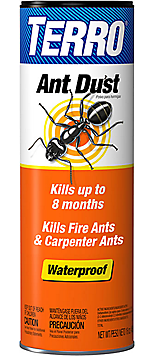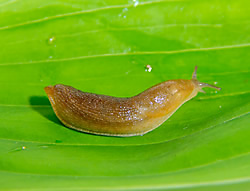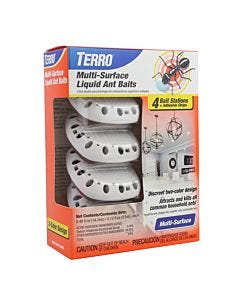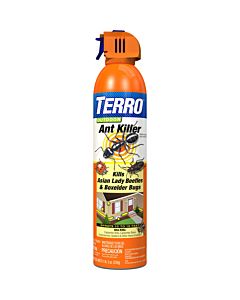
SLUGS
While slugs aren’t insects, they can be major pests for gardeners and homeowners. These slimy creatures can infest a garden and be so pervasive in your lawn that you don’t want to step outside at night. Learn all about slugs and how to eliminate them from your property.
What Are the Signs of a Slug Infestation?

A slug infestation is fairly easy to recognize. These are the most common clues that point toward slug activity:
- Slug damage to plants will appear as ragged holes around a leaf, often leaving stem pieces untouched
- Look for a silvery slime on the chewed leaves
- Look for slime trails across pavement, wood and rocks
- Seedlings usually will have all their leaves removed, but the stem will remain
- Slug damage to plants will often occur overnight or after a heavy rain
- Large slugs will leave a scalloped bite pattern on leaves
- Slugs are most active in early spring
If you want further proof, head out to your garden at night with a flashlight and look for them. They aren’t shy, so they’ll continue to munch while you observe them.
How Can I Control a Slug Infestation?
There are several methods for controlling a pre-existing slug population. Performing these tasks can significantly reduce the number of slugs in an area over a period of time.
- Water in the morning - Garden and plant experts agree that watering in the morning is best for your plants. Doing so also helps to protect your plants from slugs because the water evaporates during daylight hours. Plants and gardens that are persistently moist during overnight hours are highly attractive to slugs. Drier areas are more likely to be avoided by slugs.
- Create a Protective Ring - Protect your favorite ornamental plants – hostas, for example – with a ring of TERRO® Ant Dust which will keep slugs away. Another option for saving your ornamental plants is to apply TERRO® Multi-Purpose Insect Bait or TERRO® Perimeter Ant Bait Plus to your flowerbed.
- Expose Slug Eggs & Slug Hiding Spots - Thoroughly rake up leaf piles, straw and other debris around your garden. These areas can serve as shelters for slugs as they escape high temperatures. Further, raking the soil will expose slug eggs and cause them to dehydrate.
How Can I Get Rid of Slugs?

- Ant Dust - While “ant” is in the name of TERRO® Ant Dust, this product is highly effective at eradicating a slug population. Just sprinkle the dust around the perimeter of the area you want to protect and it will start working as soon as a slug passes over the dust. For additional protection, sprinkle the Ant Dust in areas where slugs congregate to stay moist, including cracks in sidewalks, under boards and rocks, in leaf piles and so on.
- Multi-Purpose Insect Bait or Perimeter Ant Bait Plus - Two other TERRO® products, Multi-Purpose Insect Bait and Perimeter Ant Bait Plus, should be used at the beginning of the season and every four weeks after. By broadcasting these granules in and around your ornamental plants, you will have your slug problem under control in no time.
- Beer - Making a ‘Slug Pub’ is a moderately effective way to get rid of slugs. Start by sinking a small, but deep, bowl so its lip is flush with the ground and then filling it with beer. Slugs are attracted to the smell of yeast and come to feed. As we said, this method is only moderately successful as some of the slugs, but probably not even half of them, will slide into the beer and drown.
- Ducks - Ducks are one of the few domesticated animals that eat slugs, so if you can make your yard duck friendly, you may be able to get your slug population under control. Of course, you’ll need to train those ducks to not eat your plants.
- Slug hunts - Visit your garden or lawn at night and, armed with a flashlight, bucket and old fork, go on a slug hunt. Scoop up any slugs you see and deposit them in a bucket where they will drown in a soap-and-water solution.
I Picked Up a Slug and Now My Fingers Are Slimy. What Do I Do?

While it may seem like a good idea to wash off slug mucus, don’t do it! Their mucus reacts with water, causing it to spread. Instead of washing it, rub your hand and fingers together. This causes the mucus to ball up (much the same way as rubber cement would), and it is then easy to pick off your skin. Once you’re satisfied that you’ve pulled up the slime, you should then wash your hands for sanitary reasons.
Can I Pour Salt on a Slug to Kill It?
Pouring salt on a slug will kill it in a matter of seconds, however, it generally takes quite a bit of salt to do so. The salt kills the slug through osmosis – it draws water from inside the slug and rapidly dehydrates it.
The problem with this method is that the salt can damage the nearby soil, leaving it unusable for planting for years to come. Salt can also damage other surfaces the slug may be crawling on, including wood decks, tiled floors or painted surfaces.
How Can I Stop Slugs From Entering a Flowerbed?
The best way to keep slugs out of an area is to stop them early in the season.
In the early spring, rake your flower beds and ornamental plants to remove leaves and other debris. This will also disturb and remove slug eggs at the same time.
Also work to remove any areas where slugs can shield themselves from the sun. Remove boards, flat rocks and other objects where slugs hide. Even large pieces of mulch can protect a slug. Likewise, don’t pile mulch more than 3 inches high.
An immediate option for keeping slugs out is to sprinkle diatomaceous earth around the border of the area. Slugs do not like to cross over territory covered with a rough or sharp texture that diatomaceous earth creates. An even better option is to sprinkle TERRO® Ant Dust around your ornamental plants. This will kill slugs and many other harmful plant pests, including ants, crickets, cockroaches, ticks and wasps.
Folk remedies suggest protecting your plants with a ring of crushed egg shells or sand, but this doesn’t work. In fact, snails appear to be attracted by the smell of eggs, and sand doesn’t bother them (unless they’re stuck in a desert). Coffee grounds and copper strips, two other commonly suggested folk repellents, don’t work either.
How Can I Keep Slugs From My Pet’s Food?
Slugs will invade food bowls left outside overnight. Your best bet is to simply remove the bowl after your pet has finished eating and clean up the debris. Slugs have a great sense of smell, and kibble appears to be one of those food items they will seek out.
Further, removing outdoor food bowls is a good idea for more than just preventing a slug problem. By leaving a food bowl out, you may attract even worse pests than slugs to your home!
Are There Different Kinds of Slugs?

There are dozens of slugs native to North America as well as several invasive species that have established a firm footing here. These are just a few of those species:
- California Banana Slug - This slug is often bright yellow with black spots, giving it the appearance of an old banana.
- Carolina Mantleslug - Covered in a mottle of black speckles, this slug has a head to tail mantle.
- Changeable Mantleslug - This slug has a light brown body with brown flecks.
- Dusky Slug - A small, invasive slug from Europe with light brown to yellow coloring.
- Leopard Slug - Also called the great gray slug, this invasive species has spread throughout the U.S.
- Pacific Banana Slug - Found along the Pacific Coast , this slug can reach nearly 10 inches long.
- Reticulate Taildropper - A slug with an internal shell that has a light brown to red body.
- Scarletback Taildropper - A slug with a red back and gray sides that grows to be about 2 inches long.
- Striped Greenhouse Slug - An invasive slug with a light brown body that measures only a few inches when grown.
- Three-banded Garden Slug - An import from Europe, this slug has three thin dark bands running lengthwise on its body.
- Winding Mantleslug - A small slug, less than an inch long, with flecks of dark brown.
- Yellow-bordered Taildropper - A large slug with a bright yellow border around its mantle area.





